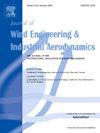考虑储备能力,减少钢筋混凝土剪力墙回风期的方法
IF 4.2
2区 工程技术
Q1 ENGINEERING, CIVIL
Journal of Wind Engineering and Industrial Aerodynamics
Pub Date : 2025-03-24
DOI:10.1016/j.jweia.2025.106045
引用次数: 0
摘要
本文提出了一种考虑高层钢筋混凝土剪力墙储备能力的减小风回期的方法。根据ACI 318-19和ASCE 7-22的要求,选取并设计了某办公楼的一组12个钢筋混凝土剪力墙。然后使用推覆分析来检查它们的侧向响应并估计风力修正因子。利用东京工业大学气动数据库的风洞压力记录,通过增量动力风分析对采用标准方法设计的建筑物和采用所提出的风力修正系数重新设计的建筑物的倒塌性能进行评价;也就是说,它们在设计风荷载作用下的失效概率。结果表明,在降低极限状态的平均递推区间的前提下,利用钢筋混凝土剪力墙的储备能力是传统弹性设计方法的可行替代方案。建议的设计程序可能有助于节省施工时间和成本。本文章由计算机程序翻译,如有差异,请以英文原文为准。
A methodology towards reducing the wind return period in reinforced concrete shear walls considering reserve capacity
This paper develops a methodology to reduce the wind return period in tall reinforced concrete shear walls considering their reserve capacity. A set of 12 reinforced concrete shear walls part of an office building is selected and designed in accordance with ACI 318-19 and ASCE 7–22. Pushover analysis is then used to examine their lateral response and estimate a wind force modification factor. Wind-tunnel pressure records obtained from the Tokyo Polytechnic University aerodynamic database are utilized to evaluate through incremental dynamic wind analysis the collapse performance of the buildings designed using the standard method, and those redesigned using the proposed wind force modification factor; namely, their probability of failure under design wind load is interrogated. The results show that leveraging the reserve capacity of reinforced concrete shear walls can represent a viable alternative to the traditional elastic design method, provided that a reduced mean recurrence interval is justified for ultimate limit states. The proposed design procedure can potentially contribute to saving construction time and cost.
求助全文
通过发布文献求助,成功后即可免费获取论文全文。
去求助
来源期刊
CiteScore
8.90
自引率
22.90%
发文量
306
审稿时长
4.4 months
期刊介绍:
The objective of the journal is to provide a means for the publication and interchange of information, on an international basis, on all those aspects of wind engineering that are included in the activities of the International Association for Wind Engineering http://www.iawe.org/. These are: social and economic impact of wind effects; wind characteristics and structure, local wind environments, wind loads and structural response, diffusion, pollutant dispersion and matter transport, wind effects on building heat loss and ventilation, wind effects on transport systems, aerodynamic aspects of wind energy generation, and codification of wind effects.
Papers on these subjects describing full-scale measurements, wind-tunnel simulation studies, computational or theoretical methods are published, as well as papers dealing with the development of techniques and apparatus for wind engineering experiments.

 求助内容:
求助内容: 应助结果提醒方式:
应助结果提醒方式:


